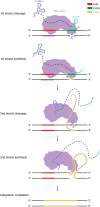Biology and utilization of R2 retrotransposons
- PMID: 40566873
- PMCID: PMC12203849
- DOI: 10.1080/15476286.2025.2521890
Biology and utilization of R2 retrotransposons
Abstract
R2 elements serve as a class of non-long terminal repeat (non-LTR) retrotransposons found in animal genomes that specifically insert into the ribosomal DNA (rDNA) sequences of host genomes. Each R2 element contains a single open reading frame (ORF) encoding a multifunctional protein with nucleic acid-binding, reverse transcriptase, and endonuclease activities, enabling specific genomic integration via a mechanism called target-primed reverse transcription (TPRT). As a classical model for studying retrotransposition mechanisms, R2 elements possess unique biological properties and precise integration capabilities, which have inspired novel genome engineering strategies. In this review, we summarize the components and integration mechanisms of R2 retrotransposons and highlight the recent advances in employing these mobile elements for targeted gene integration. Finally, we present future directions for the utilization of R2 retrotransposons as novel biotechnological tools.
Keywords: R2 retrotransposons; RNA; gene integration; genome engineering; mechanism; protein domains; reverse transcription; ribozyme.
Conflict of interest statement
No potential conflict of interest was reported by the author(s).
Figures
Similar articles
-
Lineage-Specific Evolution, Structural Diversity, and Activity of R2 Retrotransposons in Animals.bioRxiv [Preprint]. 2025 May 9:2025.05.05.652312. doi: 10.1101/2025.05.05.652312. bioRxiv. 2025. PMID: 40654615 Free PMC article. Preprint.
-
Structure and biochemistry-guided engineering of an all-RNA system for DNA insertion with R2 retrotransposons.Nat Commun. 2025 Jul 2;16(1):6079. doi: 10.1038/s41467-025-61321-z. Nat Commun. 2025. PMID: 40603868 Free PMC article.
-
Structures of vertebrate R2 retrotransposon complexes during target-primed reverse transcription and after second-strand nicking.Sci Adv. 2025 Jun 20;11(25):eadu5533. doi: 10.1126/sciadv.adu5533. Epub 2025 Jun 20. Sci Adv. 2025. PMID: 40540573 Free PMC article.
-
Systemic pharmacological treatments for chronic plaque psoriasis: a network meta-analysis.Cochrane Database Syst Rev. 2021 Apr 19;4(4):CD011535. doi: 10.1002/14651858.CD011535.pub4. Cochrane Database Syst Rev. 2021. Update in: Cochrane Database Syst Rev. 2022 May 23;5:CD011535. doi: 10.1002/14651858.CD011535.pub5. PMID: 33871055 Free PMC article. Updated.
-
Structural features and mechanism of translocation of non-LTR retrotransposons in Candida albicans.Virulence. 2014 Feb 15;5(2):245-52. doi: 10.4161/viru.27278. Epub 2013 Dec 6. Virulence. 2014. PMID: 24317340 Free PMC article. Review.
References
Publication types
MeSH terms
Substances
LinkOut - more resources
Full Text Sources
Research Materials



